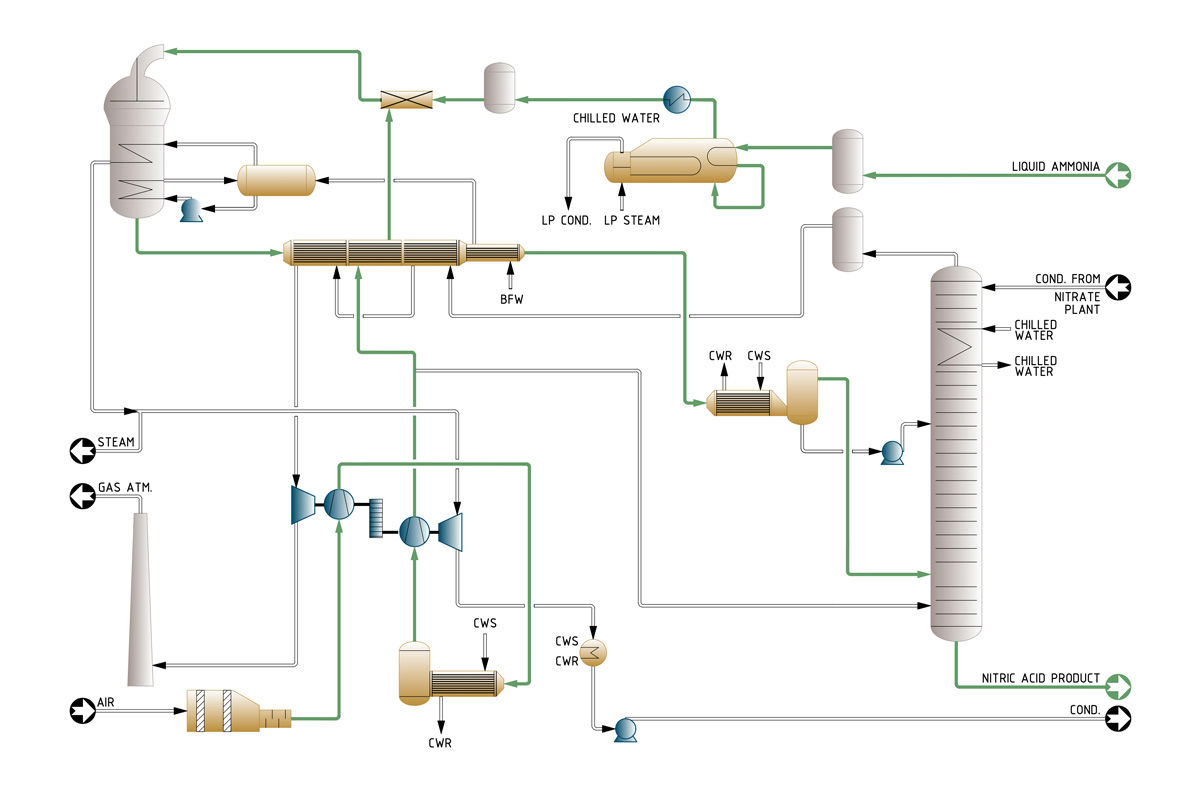WEAK HNO₃ NITRIC ACID MONOPRESSURE PROCESS
Overview
FERTlLlZERAND AZEOTROPIC GRADES
NlTRlC AClD is manufactured from Ammonia in the form of a solution of HNO in water. Concentrations of 55-60% HNO are used in the Fertilizer lndustry while azeotropic concentrations (68%HNO₃) are required by several procedures in the Chemícal Industry, mainly organic nitrations.
ESPINDESA leaded the European high pressure process in the 70’s and since then has continuously updated this technology to deal with the most severe environmental regulations and the high cost of energy. Plants for the Fertilizer Industry are still being designed by ESPINDESA with this technology.
In the last years the Industry demands giant plants and, in some cases, azeotropic concentration. However smaller units are still required being less efficient but with lower investment, these are the Nitric Acid Monopressure Plants.


In the last years the Industry demands giant plants and, in some cases, azeotropic concentration.
Process Description
Ammonia oxidation
The process air is filtered and compressed above 10 bar.
The evaporated ammonia is reheated, filtered and mixed with process air before entering the ammonia burner where Pt-Rh catalyst and getter gauzes are placed. The temperature reaches 920º C.
The heat of the process gas is recovered ina series of heat exchangers, where the temperature decreases from 920ºC to 145ºC. At this point the gases enter the cooler-condenser, which cools them below the dew point so that most of the water produced in the ammonia oxidation reaction condenses in the form ofa nitric acid stream. This is separated from the gas and pumped to the appropriate tray of the absorber.
Absorption
By the time the gases reach the inlet of the absorption tower the required oxidation of NO to NO 2 has already been completed. The internals of the absorber area set of sieve trays with integral cooling coils.
The number of trays depends on the tail gas NOx content permitted in the exhaust gas. The absorber could be designed for less than 200ppmv NOx. To reduce below 50 ppmv a catalyst for Denox abatement may be added.
The acid leaving the bottom of the absorption column is a reddish colour owing to the presence of dissolved free NO2. This is removed by countercurrent contact with the secondary air in a small sieve tray column in the bottom of absorber. After bleaching, the acid is reduced on on NO2 content .
The tail gas leaves the absorption tower at 11 bar and 30ºC and is reheated to 420ºC. The gases are sent to the gas turbine, which recovers 70% of the power needed to drive the compressor set.
The rest of the power is provided by the steam turbine.
Operating consumptions
The following table summarizes the main specific materials and utilities consumption per ton of HNO3 as azeotropic acid for a 1,000-t/d plant.
- Ammonia: 286 kg
- Steam(export): 350kg
- Catalyst, net (as Pt): 90 mg
- Electric power: 10 kWh
The HP monopressure process despite its lower efficiency compared to dual process, has lower investment cost and compact design which could include a bull gear compressor, and it is quite common for capacities lower than 400 TPD.
Process Flow Diagram


